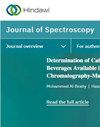Study on the Effect of Apple Size Difference on Soluble Solids Content Model Based on Near-Infrared (NIR) Spectroscopy
IF 2.1
4区 化学
Q4 BIOCHEMICAL RESEARCH METHODS
引用次数: 3
Abstract
Soluble solids content (SSC) is a vital evaluation index for the internal quality of apples, and NIR spectroscopy is the preferred technique for predicting the SSC of apples. Due to the differences in fruits’ sizes, their SSC prediction models have poor robustness and low prediction accuracy, so it is important to eliminate the effects brought by the differences in fruit sizes to improve the accuracy of fruit sorting models. The NIR spectra of apples with different fruit sizes were collected by applying NIR spectroscopy online detection device, and after various preprocessing of the spectra, the partial least squares (PLS) models of apple SSC were established, respectively, and then the modeling set in the apple fruit size group of 75 mm–85 mm was used to predict the prediction set samples in the apple fruit size group of 65 mm–75 mm and 85 mm–95 mm, respectively. To better address the effects of apple size differences, data fusion techniques were used to perform an intermediate fusion of apple fruit diameter and spectra, firstly, the competitive adaptive reweighting algorithm (CARS) and the continuous projection algorithm (SPA) were used to select spectral variables and build their prediction models for apple SSC, respectively, and the results showed that the models built with 61 spectral variables selected by CARS had better performance, greatly reduced the amount of data involved in modeling, effectively simplified the model, and improved the stability of the model. The apple size variables were added to the wavelength variables selected by CARS, and the data were normalized to establish a PLS model of apple SSC with the normalized spectral and apple fruit diameter data, and the results showed that the size compensation model based on intermediate fusion had the best prediction performance, with the prediction set Rp of 0.886 for fruit diameter of 65 mm–75 mm, RMSEP of 0.536%, and its prediction set Rp was 0.913 and RMSEP was 0.497% for the fruit diameter of 85 mm–95 mm. Therefore, adding the fruit diameter variable to establish the size-compensated model of apple SSC can improve the prediction performance of the model.基于近红外光谱的苹果粒径差异对可溶性固形物含量模型影响的研究
可溶性固形物含量(SSC)是苹果内部品质的重要评价指标,近红外光谱是预测苹果可溶性固形物含量的首选技术。由于果实大小的差异,其SSC预测模型鲁棒性较差,预测精度较低,因此消除果实大小差异带来的影响对于提高果实分选模型的准确性非常重要。利用近红外光谱在线检测装置采集不同果粒大小苹果的近红外光谱,对光谱进行各种预处理后,分别建立苹果SSC的偏最小二乘(PLS)模型,然后利用75 mm - 85 mm苹果果粒大小组的建模集分别预测65 mm - 75 mm和85 mm - 95 mm苹果果粒大小组的预测集样本。为了更好地解决苹果大小差异的影响,采用数据融合技术对苹果果实直径和光谱进行中间融合,首先采用竞争自适应重加权算法(CARS)和连续投影算法(SPA)分别选择光谱变量并建立苹果SSC预测模型,结果表明,CARS选择的61个光谱变量所建立的模型具有较好的预测效果;大大减少了建模所涉及的数据量,有效地简化了模型,提高了模型的稳定性。将苹果大小变量加入CARS选择的波长变量中,对数据进行归一化处理,利用归一化光谱和苹果果径数据建立了苹果SSC的PLS模型,结果表明,基于中间融合的尺寸补偿模型预测效果最好,对果径65 mm ~ 75 mm的预测集Rp为0.886,RMSEP为0.536%;果实直径为85 mm ~ 95 mm的预测集Rp为0.913,RMSEP为0.497%。因此,加入果径变量建立苹果SSC的尺寸补偿模型可以提高模型的预测性能。
本文章由计算机程序翻译,如有差异,请以英文原文为准。
求助全文
约1分钟内获得全文
求助全文
来源期刊

Journal of Spectroscopy
BIOCHEMICAL RESEARCH METHODS-SPECTROSCOPY
CiteScore
3.00
自引率
0.00%
发文量
37
审稿时长
15 weeks
期刊介绍:
Journal of Spectroscopy (formerly titled Spectroscopy: An International Journal) is a peer-reviewed, open access journal that publishes original research articles as well as review articles in all areas of spectroscopy.
 求助内容:
求助内容: 应助结果提醒方式:
应助结果提醒方式:


